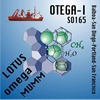

The cruise SO165-2 with the RV SONNE started in Newport, Oregon, USA and ended in San Fancisco, California. It took 17 days. On Monday, 5. August RV SONNE left Portland, OR harbor. During the 8 hour transit to the Pacific through the picturesque Columbia River gorge the different working groups on board began preparing scientific equipment and laboratories. After entering the Pacific on late Sunday afternoon a CTD profile was carried out near the Northern Summit of Hydrate Ridge early on the 6. August. After JOIDES Resolution completed drilling at ODP Leg 204 Site HR4b we occupied the first Site on the Southern Summit of Hydrate Ridge and began operations with several MUC and one TV-GRAB deployment. During this first and two further deployments of the TV-GRAB we successfully recovered large amounts of massive gas hydrate, quickly satisfying the need for samples of the biology and geochemistry groups on board. The whole scientific crew worked jointly sifting through several cubic meters of sediment to salvage a large number of samples of hydrate and carbonates. The first deployment (station 155) of the GSPT push-in tool intended to determine in situ sediment permeability on the 6. August was unsuccessful. The lower part of the "stinger" broke off after penetrating the sediment to 1m, a leaky pressure housing flooded part of the electronics package. The instrument is currently being repaired. The newly designed multi-autoclave corer MAK was assembled and deployed on the 7. and 8. August (stations 161 and 170). Due to technical problems no pressurized cores could be recovered yet. Several unsuccessful attempts were made to recover sediment cores with gravity corers, however the maximum length recovered was 1.15m. Two Lander systems for methane flare detection and quantification deployed during OTEGA I /1 were recovered. The "Flare imaging" (station 158) detected several sources of methane on the northern Hydrate Ridge (Gusher Site), an observation that was verified with CTD profiles in this area. Sea floor observations using OFOS on the slope of the northern Hydrate Ridge near the Gusher Site (station 164) confirmed earlier results on the distribution of carbonate blocks. Observations also showed that bacterial mats and associated clam fields are less abundant than on the Southern Summit.
(Text taken from http://www.gashydrate.de/projekte/omega/otega/framee.html)
Click on thumbnails to see the pictures in full size.
Leg 2 will focus on sampling and processing gas hydrate. Apart from conventional sampling devices such as the TV multicorer, TV grab, gravity corer and piston corer, a newly developed MultiAutoclavCorer (MAC) will be deployed. Using the autoclave technology, it is going to be possible for the first time to recover sediment cores under in situ pressure. Pressure preservation means that gas hydrate will not dissociate as it usually does due to changes of pressure and temperature on its way from the ocean bottom to the surface. Instead, it will be preserved within the sediment structure. Thus, we will be able to obtain pore water profiles with minimized effects of gas hydrate dissociation. One important feature will be positive anomalies of chloride around gas hydrate layers. Pore water profiles obtained so far from the gas hydrate deposits of Hydrate Ridge were always affected by decompression and the time-consuming dissection of samples. An advanced stage of dissociation, which had been reached before small samples could be taken, was expressed by a marked freshening of the samples (negative anomalies of chloride). In addition, a set of autoclave samples will be put through computer tomography to image the internal structure of gas hydrates under in situ conditions. Another main task will be determining basic physical properties of sediment containing gas hydrate. A SwordFish system developed by Christian Situ, Vancouver/ Can. will be deployed for this purpose. A remotely controlled, 6 m long penetrating sensor collects information on several parameters such as in situ pore water pressure, permeability, density, water content and shear wave velocity. It can also take pore water samples (water and gas), preserving their hydrostatic pressure. They serve for calculating the amounts of fluid and gas getting from the sediment into the hydrosphere on diffuse, unchanneled ways. On Leg 2, the radio tracer incubation experiments for determination of microbial turnovers of methane and sulfate are to be continued, extended by detection of AOM activity in sediments above gas hydrate and directly within gas hydrate layers under laboratory conditions (in vitro). Furthermore, samples will be used to cultivate the AOM consortium and develop AOM active mesocosms. The experiments will be complemented by molecular biological analyses of the diversity of microbial symbiotic consortia within the sediment and an identification and quantification of microorganisms directly associated with gas hydrate.
If you need more information, download the complet cruise report.
Back to the main page of my ship cruises, there is a lot of other interesting stuff to see